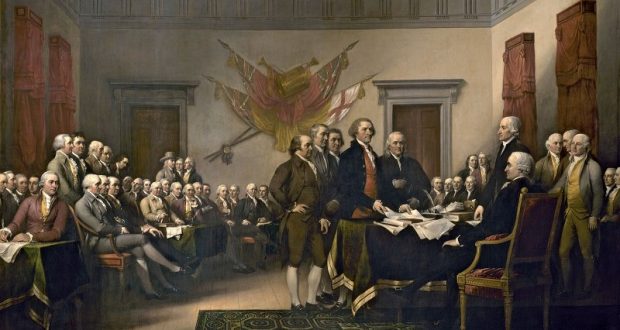By Sal Maccarone
Before the camera made it so easy for us to document specific moments in time, the job was left up to the artistically inclined. The only visual record of what people looked like, or how events happened to unfolded are depictions made by artists. Before 1822 the world relied strictly on those skillful and insightful enough to leave us a proper record. Portraits, paintings and sculpture are what link us to the past.
Historical painting is usually described by the subject matter rather than a style; such as, a portrait of a person, or a portrayal of an event. In the case of portraying an event, similar to the news correspondents of today’s world, it took an eye witness to accurately illustrate what had taken place. Sometimes an observer would be there specifically to record the event, but oftentimes it was a just a matter of circumstance.
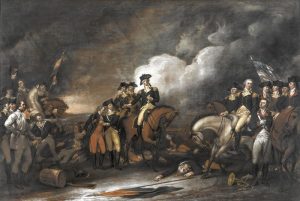 As an enlisted soldier during the American Revolution, John Trumbull (1756-1843), would become a first hand witness to the war. His detailed sketches of the British garrisons near Boston aided the revolutionary cause. So much so that it won him a post as a personal aid to General George Washington. He was present at the Battle of Bunker Hill on June 17, 1775. His extraordinary painting titled, “The Death of General Warren” is actually a first hand account of that battle.
As an enlisted soldier during the American Revolution, John Trumbull (1756-1843), would become a first hand witness to the war. His detailed sketches of the British garrisons near Boston aided the revolutionary cause. So much so that it won him a post as a personal aid to General George Washington. He was present at the Battle of Bunker Hill on June 17, 1775. His extraordinary painting titled, “The Death of General Warren” is actually a first hand account of that battle.
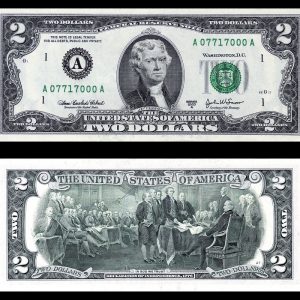 After his service as a solder he was encouraged by Washington to study under Benjamin West (1738-1820), who was one of the foremost historical painters of that time. Ben West helped the young painter to harness his raw talent and also taught him how to capture the essence of a historical moment. Well, he did a great job with his apprentice because John Trumbull went on to give us a glimpse at some of the most important moments of the American Rebellion. His twelve by eighteen foot oil painting titled, “Declaration of Independence”, which he painted in 1817, graces the United States Capitol Rotunda. He was coached by none other than Thomas Jefferson himself who commissioned the painting on behalf of Congress. This painting is so important that it later was etched by Asher Brown Durand (1796-1886) on to a plate, and stamped on the reverse of our two dollar bill; and of course, Thomas Jefferson is on the other side.
After his service as a solder he was encouraged by Washington to study under Benjamin West (1738-1820), who was one of the foremost historical painters of that time. Ben West helped the young painter to harness his raw talent and also taught him how to capture the essence of a historical moment. Well, he did a great job with his apprentice because John Trumbull went on to give us a glimpse at some of the most important moments of the American Rebellion. His twelve by eighteen foot oil painting titled, “Declaration of Independence”, which he painted in 1817, graces the United States Capitol Rotunda. He was coached by none other than Thomas Jefferson himself who commissioned the painting on behalf of Congress. This painting is so important that it later was etched by Asher Brown Durand (1796-1886) on to a plate, and stamped on the reverse of our two dollar bill; and of course, Thomas Jefferson is on the other side.
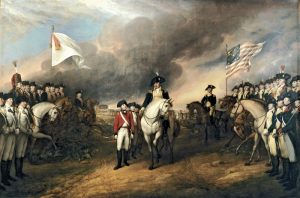 John Trumbull also became a brilliant portrait painter who left us renderings of his friends, George Washington, John Adams, Alexander Hamilton and Thomas Jefferson. His portrait of Hamilton was the source for the picture on the ten dollar bill. His 1792 oil on canvas painting titled, “George Washington Before the Battle of Trenton”, is probably the best known likeness that we have of our first President. Some of his other important paintings include: “Surrender of General Burgoyne”, “Washington Resigning his Commission” and “The Sortie Made by the Garrison of Gibraltar”. Two of these and some others can be seen on the Metropolitan Museum of Art’s website, (www.metmuseum.org).
John Trumbull also became a brilliant portrait painter who left us renderings of his friends, George Washington, John Adams, Alexander Hamilton and Thomas Jefferson. His portrait of Hamilton was the source for the picture on the ten dollar bill. His 1792 oil on canvas painting titled, “George Washington Before the Battle of Trenton”, is probably the best known likeness that we have of our first President. Some of his other important paintings include: “Surrender of General Burgoyne”, “Washington Resigning his Commission” and “The Sortie Made by the Garrison of Gibraltar”. Two of these and some others can be seen on the Metropolitan Museum of Art’s website, (www.metmuseum.org).
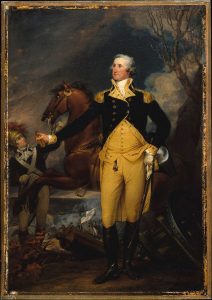 Some interesting facts: John Trumbull lost his sight in one eye because of a childhood accident. This accounts for his very detailed style of painting. He is also credited with introducing Maria Cosway, also a painter, to Thomas Jefferson in 1786. Jefferson and Cosway became intimate friends until his death on July 4th, 1826, which just happened to be fifty years to the day after the signing of the Declaration of Independence.
Some interesting facts: John Trumbull lost his sight in one eye because of a childhood accident. This accounts for his very detailed style of painting. He is also credited with introducing Maria Cosway, also a painter, to Thomas Jefferson in 1786. Jefferson and Cosway became intimate friends until his death on July 4th, 1826, which just happened to be fifty years to the day after the signing of the Declaration of Independence.
Sal Maccarone

